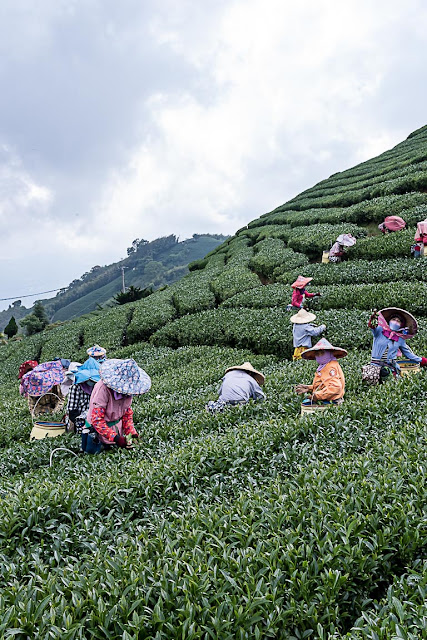Last week, Alishan was busy with its spring Oolong harvests. I encountered few cars on the mountain roads, because I travelled on a Wednesday. Taiwanese tea fans usually do their direct shopping Saturday or even Sunday. During the week, you mostly encounter the farmers in their SUVs, the pickers on their motorcycles and the logistics guys in their trucks. Bed and breakfast hotels are deserted, except in the most touristic areas of the Alishan National Park, where retirees are enjoying the promotions valid from Monday to Thursday.
In terms of weather, this spring is a return to normal compared to last year, when we witnessed one of the most severe drought in years in Central Taiwan. The return of winter rain has helped fill the reservoirs and has increased yields in most plantations. This explains the good news that, despite some increases in energy and fertilizer costs, the wholesale prices of Jinxuan and Qingxin Oolong have remained pretty much stable compared to last year.
In terms of manpower, the countryside continues to have difficulty to attract young and strong young people willing to work hard (12 hours in a row) in the tea factories. That's why this machine is getting more and more popular. It simply compresses the leaves into a cube, as you may see below.
The pressing of the leaves is how they are now taking their compressed, roundish shape. This doesn't happen in one pressing. The cube of Oolong leaves is then brought into the kill green oven, where the leaves disconnect from each other. Then, the leaves are placed again in the compression machine... After several times, they take the proper shape and then just remain to be dried.
This machine has replaced another machine that would keep on turning the leaves placed in a cloth of textile. And because fewer leaves fitted in these cloth than in the compression machine, more manpower was required for this work. This is a quite recent innovation that has increased the productivity in the tea farms and has helped keep prices steady for consumers (except for international shipping prices)
How about quality? As I'm observing every year, weather conditions keep on changing from one day to another and even from one hour to another. This makes tea processing very difficult, because the drying and oxidation steps can be quickened or slowed down by these changes in the weather. So Oolong making in the mountains can't rely on a SOP, Standard Operating Practice. The maker must always adjust and that's why each new batch will be a little bit different from the previous batch. And some will necessarily be sweeter, or more powerful, or better oxidized... than others.
I'm very glad with the
Jinxuan Oolong and the
Qingxin Oolong I selected from this farm in RuiFeng, Alishan/Meishan. They express the energy of Alishan and the freshness of spring with great clarity and sweetness.
As for the pickers, the travel restrictions put in place in Taiwan with the Covid continue to lead to staff shortages. That's why, like last year, as you can see on this picture, there are some male workers who are joining the ladies! This guy was driving a little bit too quickly and the hat of his passenger was blown off her!
On this plantation, the pickers were mostly young Vietnamese women and a few men, or older Taiwanese ladies. At least in the mountains, the picking continues to be done by hand! This is one of the reasons for the exceptional sweetness of high mountain Oolongs...
Tea leaves are so fantastic and precious! They deserve to be handled with the greatest care, during the picking, the manufacturing and the brewing!
Enjoy your
spring High mountain Oolongs and
spring Wenshan Baozhong selected for you in Taiwan since 2005!






















